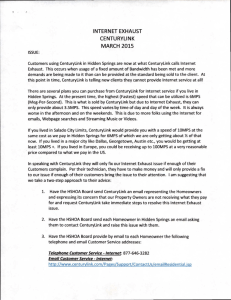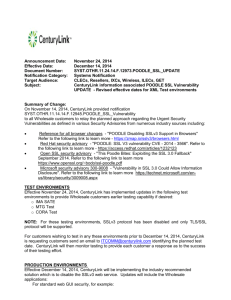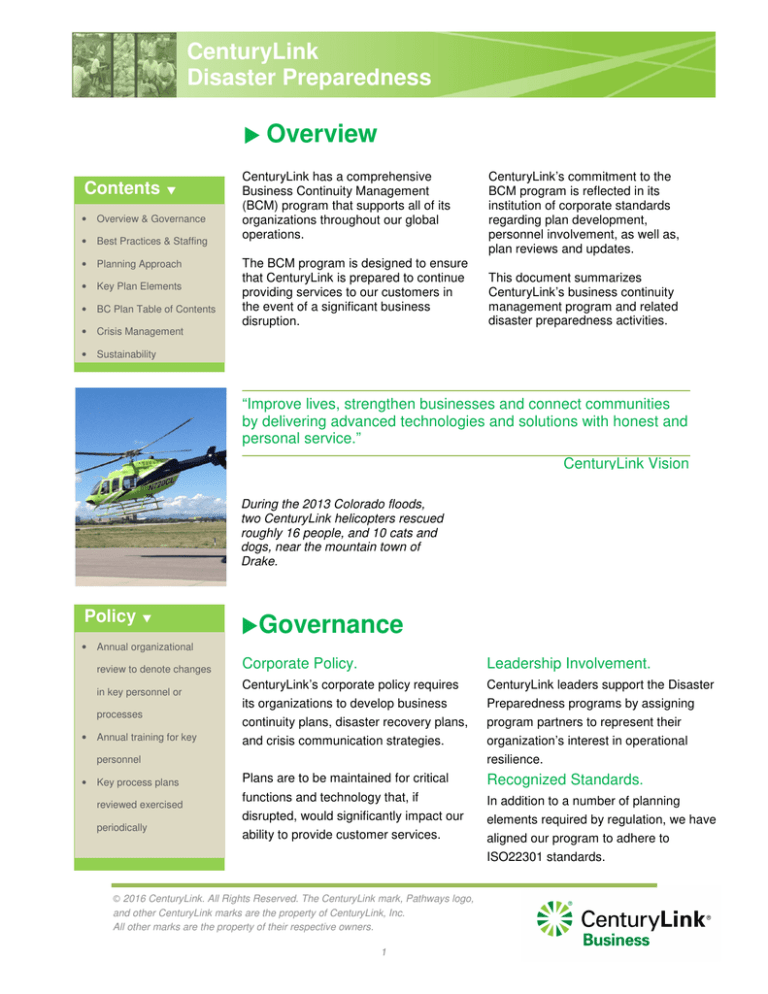
CenturyLink
Disaster Preparedness
Overview
Contents
•
Overview & Governance
•
Best Practices & Staffing
•
Planning Approach
•
Key Plan Elements
•
BC Plan Table of Contents
•
Crisis Management
•
Sustainability
CenturyLink has a comprehensive
Business Continuity Management
(BCM) program that supports all of its
organizations throughout our global
operations.
The BCM program is designed to ensure
that CenturyLink is prepared to continue
providing services to our customers in
the event of a significant business
disruption.
CenturyLink’s commitment to the
BCM program is reflected in its
institution of corporate standards
regarding plan development,
personnel involvement, as well as,
plan reviews and updates.
This document summarizes
CenturyLink’s business continuity
management program and related
disaster preparedness activities.
“Improve lives, strengthen businesses and connect communities
by delivering advanced technologies and solutions with honest and
personal service.”
CenturyLink Vision
During the 2013 Colorado floods,
two CenturyLink helicopters rescued
roughly 16 people, and 10 cats and
dogs, near the mountain town of
Drake.
Policy
•
review to denote changes
in key personnel or
processes
•
Governance
Annual organizational
Annual training for key
Corporate Policy.
Leadership Involvement.
CenturyLink’s corporate policy requires
CenturyLink leaders support the Disaster
its organizations to develop business
Preparedness programs by assigning
continuity plans, disaster recovery plans,
and crisis communication strategies.
program partners to represent their
organization’s interest in operational
resilience.
personnel
•
Key process plans
Plans are to be maintained for critical
Recognized Standards.
reviewed exercised
functions and technology that, if
disrupted, would significantly impact our
In addition to a number of planning
elements required by regulation, we have
ability to provide customer services.
aligned our program to adhere to
periodically
ISO22301 standards.
© 2016 CenturyLink. All Rights Reserved. The CenturyLink mark, Pathways logo,
and other CenturyLink marks are the property of CenturyLink, Inc.
All other marks are the property of their respective owners.
1
CenturyLink
Disaster Preparedness
Best Practices
CenturyLink’s program and plans have
been developed with the involvement of
certified business continuity
professionals (MBCP, CBCP, and
MBCI), who incorporate best practices
acknowledged by Disaster Recovery
Replacing a pedestal from
Institute International (DRII) and the
Business Continuity Institute (BCI).
the 2014 Washington State
wildfire.
Best practices employed by CenturyLink
include, but are not limited to:
Threat Assessment & Business
Impact Analysis results as a basis for
Business Continuity planning
Geographic diversity of recovery
resources
Consideration of third-party resources
Multiple business resumption options
for critical functions
Routine plan reviews, updating and
testing
Consistent and integrated planning
approach across the enterprise
Disaster Preparedness Staffing
Team
Roles & Responsibilities – All Levels
CenturyLink leaders are responsible for providing direction following an event that may
Leadership
have consequences beyond those typically managed by the corresponding Event
Management team.
Four regional teams are led by regional operations directors and comprised of
Regional Event Management
representation from all critical business and support units at the local level. These teams
are activated when there is an event that affects, or has the potential to affect, one or
more business units or key functions in a geographic area.
CenturyLink staffs a full-time group of disaster preparedness professionals to oversee
and support all elements of the corporate program. Staff members hold CBCP and MBCI
Disaster Preparedness
certifications, graduate degrees, and have experience in telecommunications or IT
operations. Supported elements include: Business Continuity Management, Disaster
Recovery, Workforce Contingency Planning, Crisis Response and Communications
Management.
CenturyLink’s business units are represented within this structure and activated
whenever there is a severe, multi-region business interruption or potential threat to the
Crisis Communications
corporation at large. Primary and alternate team members provide corporate-wide
resources to assist regional teams in addressing key issues, identifying support needs,
and coordinating recovery activities within their respective business units. Team
members participate in drills, crisis simulations, and receive annual training.
© 2016 CenturyLink. All Rights Reserved. The CenturyLink mark, Pathways logo,
and other CenturyLink marks are the property of CenturyLink, Inc.
All other marks are the property of their respective owners.
2
CenturyLink
Disaster Preparedness
Team
Roles & Responsibilities – All Levels
Disaster Preparedness resources within each organization, and subsequent business
unit, are responsible for assisting in the identification of key business processes and
Business Continuity Managers &
Planners
their resource recovery needs. These individuals engage subject matter experts to
validate the developed plans through the review and exercise process.
This group is responsible for all application and hardware recovery plans, as well as
integrating outage management with Disaster Preparedness’s crisis communications
IT Disaster Recovery Services
activities. This group coordinates the IT Incident Management Team, which is a
“SWAT-like” team designed to manage rapid application recovery.
These teams include individuals familiar with network elements, engineering and
construction processes who mobilize on short notice. People used in this effort have
Damage Assessment &
hands-on experience or working knowledge of the network infrastructure and may
Rapid Response
include engineers, technicians or other subject matter experts with the training and
skills to make accurate preliminary reports.
The Network Reliability Operations Center (NROC) organization staffs a 24x7x365
center that monitors our telecommunications network to rapidly identify potential issues
Network Reliability Operations
Center
and respond to real-time outages. The NROC is the focal point for network restoration,
and is an integral component of the overall crisis management structure.
CenturyLink is committed to protecting the environment and the health and safety of
our employees, customers and the communities we serve by conducting our business
in a safe and environmentally responsible manner. The Environmental Health and
Environmental Health & Safety
Safety staff provides support to the business units and is engaged at all levels during
major events or disasters.
© 2016 CenturyLink. All Rights Reserved. The CenturyLink mark, Pathways logo,
and other CenturyLink marks are the property of CenturyLink, Inc.
All other marks are the property of their respective owners.
3
CenturyLink
Disaster Preparedness
Planning Approach
In order to avoid disruptions to services,
you need to have a plan. We have a
plan. In fact, we have several plans that
are designed to minimize disruption of
Approach
CenturyLink services. The plans
address critical internal business
functions that, if disrupted, could lead to
service outages.
Planning Description
CenturyLink recognizes that large enterprises continually increase in complexity and interdependence, and that no functions operate in isolation. Accordingly, CenturyLink’s
business continuity plans address critical functions concerning the recoverability of
Enterprise-Wide Scope
CenturyLink’s technological infrastructure, the ability to provide customer support to new
and existing customers, and the ability to receive and fulfill customer orders. Each of these
plans recognizes and accounts for operational interdependencies involving both internal
and external resources. CenturyLink’s plans engage company resources from around the
globe for the purposes of continuing critical business functions.
CenturyLink’s all-hazards approach to business continuity planning focuses on the impacts
that may result from a broad range of natural disasters, infrastructure failures, and human-
All-Hazards Planning
induced disasters. Consequently, CenturyLink’s business continuity plans enable the
company to respond to a myriad of disaster-related impacts to include site closures,
technology and infrastructure failures, external vendor/contractor disruptions, employee
impacts, pandemics, and others.
CenturyLink employs the use of multiple business continuity strategies in business
continuity plans. By using a combination of mutual support agreements, remote work
Strategic Diversity
arrangements, technology failover and redundancy and third-party agreements, we believe
that our plans enable us to effectively respond to business disruptions. This approach
allows us to respond, even in light of the uncertain and the dynamic nature of current and
potential threats.
© 2016 CenturyLink. All Rights Reserved. The CenturyLink mark, Pathways logo,
and other CenturyLink marks are the property of CenturyLink, Inc.
All other marks are the property of their respective owners.
4
CenturyLink
Disaster Preparedness
Approach
Planning Description
The CenturyLink Compliance Management team is dedicated to continually
improving and maintaining compliance certifications that are critical to our
customers. Through our disciplined assessment and audit processes, CenturyLink
Compliance Management
has implemented comprehensive practices for SSAE 16 SOC 1, SOC 2, PCI DSS,
ISO 27001, Safe Harbor, Global Risk Management, Business Continuity and
Disaster Recovery (BCDR), HIPAA, and FISMA (NIST 800-53). We engage external
audit firms to perform multiple types of assessments designed to address our
customers’ diverse compliance requirements.
Public Health
CenturyLink has incorporated into its business continuity planning a methodology to
Risks/Staffing/Absenteeism
address potential or significant disruptions in employee staffing levels. A Health Risk
Assessment and Strategic Response plan has been implemented to establish a
framework which potential health risks (contagious and non-contagious) can be
identified, assessed, monitored and acted upon if necessary. The plan provides a
system of on-going and proactive situational awareness to identify potential health
risks to the organization; creates an internal Strategic Health Risk Management
Team to assess impacts to the organization and establish and implement plans and
protocols to mitigate the impact of the risk on CenturyLink; establishes general health
maintenance procedures to be implemented throughout the organization to prepare
for and minimize routine health risks; and develops threat specific guidelines to assist
in understanding preparation and response to health risks. Additionally, CenturyLink
maintains a comprehension wellness program that includes influenza vaccinations at
no-charge.
Dedicated Resources
CenturyLink has dedicated business continuity resources on a full-time and a parttime basis. Full-time disaster preparedness managers act as internal consultants to
business units to identify and help implement planning needs. Subject matter experts
and leaders within each business unit provide detailed technical expertise to support
the development and maintenance of preparedness activities.
Training & Awareness
Strategic CenturyLink employees participate in quarterly disaster awareness
meetings, business continuity training, and receive targeted emails.
Exercise Resources
CenturyLink performs annual testing through checklist, tabletop, simulation exercise
or actual events. Any gaps are identified, documented and tracked to resolution.
© 2016 CenturyLink. All Rights Reserved. The CenturyLink mark, Pathways logo,
and other CenturyLink marks are the property of CenturyLink, Inc.
All other marks are the property of their respective owners.
5
CenturyLink
Disaster Preparedness
Key Plan Elements
While specific business continuity plan
CenturyLink uses a standard planning
contents are proprietary, CenturyLink is
pleased to summarize plan contents for
model across the enterprise to facilitate
consistency in planning and to optimize
its current and future customers, and for
integration of departmental plans. Major
its insurers.
plan elements include:
Approach
Planning Description
Immediate Actions
As business disruptions frequently accompany emergency situations, CenturyLink plans
describe how employees transition from an emergency situation to business resumption
activities, whether they are at the office or away from work.
Internal Communications
CenturyLink plans describe internal communications that are required to engage company
resources in order to implement business continuity measures and to inform appropriate
CenturyLink departments and employees that may be impacted by the event.
Business Resumption
CenturyLink plans provide department-specific, step-by-step instructions and/or options
Procedures
that will be implemented to resume critical functions if a CenturyLink site is inaccessible or
if essential resources are unavailable. Procedures may involve transition of work to
alternate locations, re-prioritization of work activities, establishing virtual offices,
implementing manual contingencies, and others.
External Communications
CenturyLink plans describe how the company will communicate with customers, suppliers,
contractors, business partners, media and other entities that may be impacted by a
disruption or are vital to continuing critical business functions. CenturyLink is a member of
the National Communications System to ensure telecommunications are available and
prioritized through the Government Emergency Telecommunications Service and Wireless
Priority Service.
Vital Resources
CenturyLink plans describe how departments obtain resources that are necessary to
perform critical functions. Resources may include vital records and data, computing
equipment, human resources, and others.
© 2016 CenturyLink. All Rights Reserved. The CenturyLink mark, Pathways logo,
and other CenturyLink marks are the property of CenturyLink, Inc.
All other marks are the property of their respective owners.
6
CenturyLink
Disaster Preparedness
Approach
Planning Description
Disaster Service Support
CenturyLink retains support for disaster services in the areas of cloud services, facility
recovery, records recovery, and telecommunications recovery. These services assist
CenturyLink by providing technical telecommunications support related to network element
protection, response and recovery recommendations.
Mutual Aid
CenturyLink has agreements with major telecommunication companies to provide mutual
support in the event of a disaster. CenturyLink has both provided and received support as
a result of the mutual aid agreement. Examples of when support was both given and
received include a recent flood and hurricane.
Disaster Recovery Trailers
CenturyLink owns seven mobile switching trailers that can be rapidly deployed to assist in
the recovery of a damaged switch location. Trailers are geographically dispersed for
nationwide deployment and operate on both commercial power and an on-board diesel
generator.
BC Plan Table of Contents
Business Continuity Plans.
This is an outline of the plan contents and it describes the actions to be taken in the
event that critical business functions are disrupted.
© 2016 CenturyLink. All Rights Reserved. The CenturyLink mark, Pathways logo,
and other CenturyLink marks are the property of CenturyLink, Inc.
All other marks are the property of their respective owners.
7
CenturyLink
Disaster Preparedness
Crisis Management Structure
Crisis Management Structure.
While we are proud of our continuity
planning, we also know that disasters
happen, and we must be ready to
respond to them quickly.
Crisis Management Framework.
CenturyLink has developed a three-layer
crisis management approach. Regional,
National and International Command
Centers involve key leaders, decisionmakers, and subject matter experts at all
levels of the organization.
The system is similar to the Incident
Command System used by federal
response agencies, but is tailored to
meet the needs of CenturyLink.
Team members participate in an annual
exercise, as well as more frequent
activation drills.
Command Centers
The corporate Command Center is located in Littleton, Colorado. It is
equipped with multiple media sources, telecommunications diversity,
HF radio, emergency power, robust computer support, and various
emergency supplies.
CenturyLink also maintains regional Command Centers that are
equipped with, at a minimum, emergency power, and robust IT and
telecommunications.
© 2016 CenturyLink. All Rights Reserved. The CenturyLink mark, Pathways logo,
and other CenturyLink marks are the property of CenturyLink, Inc.
All other marks are the property of their respective owners.
8
CenturyLink
Disaster Preparedness
Crisis Management Support
CenturyLink has established contractual
relationships with several disaster
services companies to assist in recovery
operations.
These service companies are
available to provide 24x7x365
24x7x36
support nationwide.
nationwide
CenturyLink maintains contracts
that provide telecommunicationstelec
specific support.
Geographic Information Systems
We believe that our risk assessment
decision support is greatly enhanced by the
use of Geographic Information Systems
(GIS). This enables CenturyLink to rapidly
acquire situational awareness during an
event, thus improving decision-making
making and
reducing the time required to make those
decisions.
CenturyLink continuously expands its use
of GIS by building or updating additional
layers of information gained during a
business impact analysis and site threat
assessments. CenturyLink gets automated
alerts based on the proximity of incidents to
more than 70,000 sites that we monitor for
a fast response.
© 2016 CenturyLink. All Rights Reserved. The CenturyLink mark, Pathway
Pathways logo,
and other CenturyLink marks are the property of Cen
CenturyLink, Inc.
All other marks are the property of their respective owners.
9
CenturyLink
Disaster Preparedness
Environmental Sustainability
Super Storm Sandy drew attention to the increasing climate
climate-related
risks for communities and businesses. Weather related disasters are
happening more frequently and with greater intensity. CenturyLink
supports greening initiatives that aid the environment while align
aligning
with recovery objectives. That is why the CenturyLink Environmental
Sustainability Governance Council, the
he “Green Team,” was created.
CenturyLink’s risk-based
based approach to disaster mitigation focuses on
the hydrological cycle, biodiversity, slope
slope, topography, water quality,
and climate.
Storm hardening requirements are
considered in the engineering and
design process. This elevated cabinet,
positioned on coastal terrain, was built
20 feet in the air to avoid storm surge.
Alternative Energy. CenturyLink is expanding its sustainability
commitments by installing Bloom Energy fuel cells to generate up to 500
kilowatts of clean power for one of its Irvine, California data centers. This
configur
configuration
ation enables CenturyLink to receive primary power for its critical loads
from Bloom Energy Servers, protecting those loads from electrical outages
without the need for ba
backup
ckup UPS and generator systems.
Environmentally Sound Disaster Strategy. Although
though our industry
faces many environmental challenges, CenturyLink is committed to working
toward solving them. CenturyLink uses remote work strategies to minimize
the impact to customers and the environment during disasters.
Environmentally sound data center design and virtualization contribute to
resiliency, high availability, and recoverability.
Contact Us
For more information, please
contact CenturyLink Disaster
Preparedness:
DPER@CenturyLink.com
© 2016 CenturyLink. All Rights Reserved. The CenturyLink mark, Pathway
Pathways logo,
and other CenturyLink marks are the property of Cen
CenturyLink, Inc.
All other marks are the property of their respective owners.
10

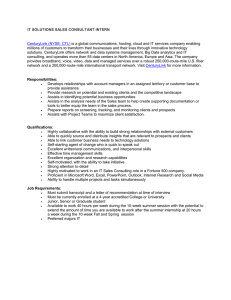
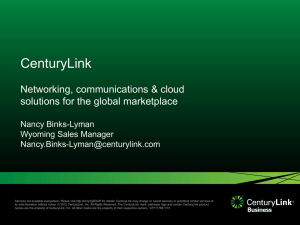
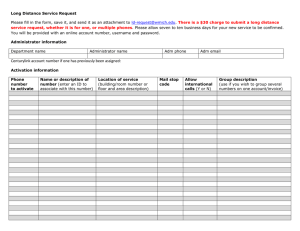
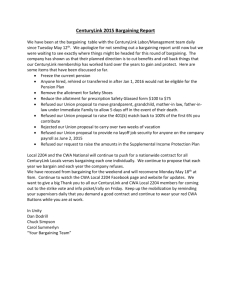
![CenturyLink [PPT]](http://s2.studylib.net/store/data/005561373_1-dc9a5c20956491e26756b6befaa579a4-300x300.png)
